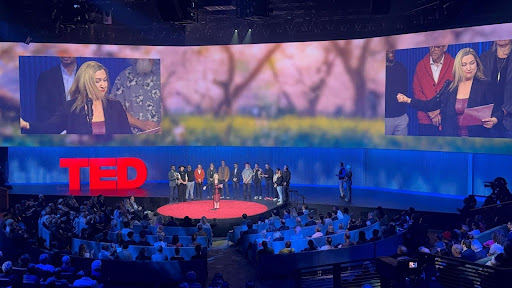
In the middle of a recent TED conference futurist Cathy Hackl captivated audiences with an experiment that explored the blurry intersection of human emotion and artificial intelligence. Known for her pioneering work at Magic Leap, where she helped launch the virtual human Mica and introduced C-level executives to embodied AI for the first time, Hackl has long been at the forefront of human-computer interaction. Her latest experiments take that vision even further, probing how we might use AI not just to assist us, but to understand and evolve our most human experiences: connection, heartbreak, and love.
Her TED journey began with a matchmaking experiment using AI, an unconventional but compelling approach that earned her an invitation to the main stage. But Hackl isn't done. In her next experiment, she'll spend a week "dating" four different AIs, allowing them to compete for her attention and even advise her on who to choose and how to end things. It's part social study, part tech demo, and part emotional audit. Recently, she also turned to AI vibe-coding tools to help navigate the emotional fallout of a breakup, effectively gamifying grief and reframing romantic recovery.
All of this is in service of a bigger idea: The Tech Intimacy Scale, Hackl's soon-to-launch framework designed to help people measure and improve their digital relationships. As we shift from the attention economy to what she calls the "intimacy economy," Hackl believes that the future of tech is not about replacing human connection, but enhancing it.
From low-intimacy interactions like swiping on dating apps to high-intimacy tools like immersive storytelling in augmented and virtual reality, the scale assesses not just how we use technology, but how it makes us feel. Her goal is not to vilify technology, but to encourage a more thoughtful, emotionally intelligent design and use of it.
Just as Brené Brown brought the language of vulnerability and shame to the forefront of emotional literacy, Hackl is crafting a new vocabulary to measure and guide intimacy in digital environments. Brown's groundbreaking work helped people see the power of vulnerability in forging trust and belonging, Hackl takes this further by exploring how technology can either amplify or diminish those vulnerable moments.
Similarly, Scott Galloway has repeatedly emphasized how macroeconomic and demographic shifts have eroded traditional relationship structures, especially among young men. In his books and interviews, Galloway points to declining male participation in romantic relationships as both a symptom and cause of broader social detachment. Hackl's ideas provide a complementary lens, while Galloway diagnoses the problem, Hackl begins to architect solutions, imagining digital ecosystems that foster emotional intelligence and nuanced human interaction through immersive tech, gamification, and AI-powered connection tools.
Derek Thompson, writing in The Atlantic, has expertly unpacked the "loneliness epidemic" and its correlation to technology, noting how social platforms create an illusion of community while often leaving users feeling more isolated. Hackl acknowledges this dissonance and instead seeks to reverse the trend by advocating for intentional, emotionally aware technology that prioritizes genuine connection. Where Thompson cautions about technology's unintended consequences, Hackl outlines a roadmap for repurposing those same tools to rebuild social capital and emotional resonance.
Mel Robbins, known for her practical advice and behavioral triggers like the "5 Second Rule," focuses on motivating individuals to take action in their personal and professional lives. Hackl's approach similarly invites users to be proactive, but in their digital relationships, urging individuals not to passively consume connection through endless swipes, but to "play more," engage authentically, and use immersive storytelling to build emotional presence. Robbins encourages behavior change in daily life; Hackl extends that to the virtual spaces where people increasingly spend their time.
What makes Hackl's work particularly timely is that it doesn't exist in a vacuum. She is both reflecting on and contributing to a wider movement toward intentional living, vulnerability, and connection. Hackl is building a framework that acknowledges our loneliness crisis without resigning to it. Instead, she invites creators, developers, and users to take part in a more emotionally intelligent technological future one that, like the work of Brown, Galloway, Thompson, and Robbins, reminds us that connection is both a need and a skill, whether offline or on.
Technology isn't the enemy of intimacy. When used with awareness and intention, it can be its greatest ally.









